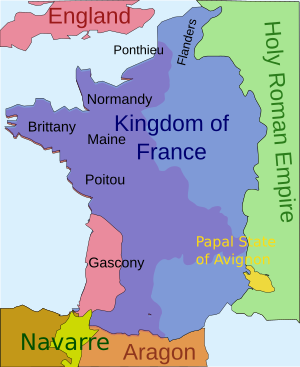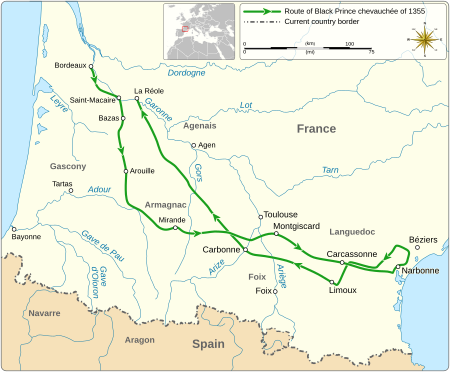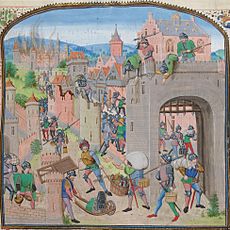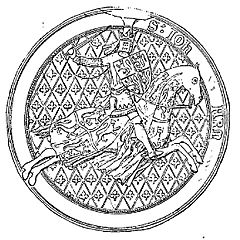Black Prince's chevauchée of 1355 facts for kids
Quick facts for kids Chevauchée of the Black Prince (1355)Grande chevauchée |
|||||||
|---|---|---|---|---|---|---|---|
| Part of Hundred Years' War | |||||||
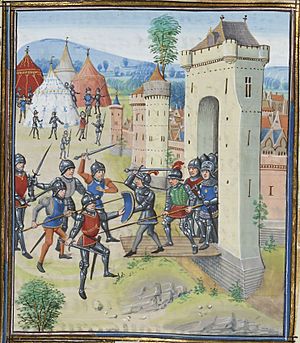 A medieval town under assault. A miniature from a chronicle by Jean Froissart. |
|||||||
|
|||||||
| Belligerents | |||||||
| Commanders and leaders | |||||||
|
|||||||
| Strength | |||||||
| 5,000–8,000 | Unknown | ||||||
| Casualties and losses | |||||||
| Unknown, but few | Unknown | ||||||
The Black Prince's chevauchée, also known as the grande chevauchée, was a huge mounted raid. It was led by Edward, the Black Prince, who was the son of the English king. This raid happened between October 5 and December 2, 1355. It was an important part of the Hundred Years' War between England and France.
The Anglo-Gascon army had between 4,000 and 6,000 soldiers. They marched about 300 miles from Bordeaux in English-controlled Gascony to Narbonne. Then they marched all the way back. They destroyed a large part of French land and took many valuable things from towns. The French commander, John, Count of Armagnac, avoided fighting a big battle.
Even though no land was captured, France suffered huge economic damage. One historian said the damage was incredibly important. After this raid, the English kept fighting. They captured over 50 French towns and forts in the next four months. In August 1356, the Black Prince led another raid north. This time, he met the main French army and won a huge victory at the Battle of Poitiers. He even captured the French King, John II of France.
Contents
Why Did the Raid Happen?
The Start of the Hundred Years' War
Since 1066, English kings had owned lands in France. This meant they were like "vassals" (loyal subjects) to the French kings. But there were many disagreements between Philip VI of France and Edward III of England.
In 1337, the French King Philip decided to take back the lands Edward III held in France. He said Edward wasn't following his duties as a vassal. This decision started the Hundred Years' War, which lasted for 116 years.
Gascony: A Key English Territory
Gascony was very important to England. Over 1,000 ships left Gascony each year, carrying huge amounts of wine. The taxes on this wine from Bordeaux, Gascony's capital, brought in more money for the English king than all other taxes combined. Bordeaux was a big, rich city, even bigger than London at the time.
However, French attacks had made English Gascony smaller. It had to import most of its food, often from England. If shipping was stopped, Gascony could starve, and England would lose a lot of money. The French knew this well.
England often didn't have many soldiers to send to Gascony. So, the Gascons usually had to defend themselves. In 1339, the French even attacked Bordeaux.
A Break in the Fighting
In 1347, the English captured the French port of Calais. After this, a truce was signed because both countries were running out of money. Around the same time, the Black Death (a terrible plague) arrived. It killed about 45% of the population in both countries.
Fighting continued in some areas, but there were no big battles. Peace talks started in 1353, but they failed in early 1355. So, Edward III decided to launch new attacks in both northern France and Gascony.
Getting Ready for the Raid
Before this raid, the English had pushed the French away from Gascony's main areas. This helped protect Gascony's food supplies. But many French castles and towns were still inside what was supposed to be English land.
To the south was the County of Armagnac. This area had not been touched much by the war. It was the home of John, Count of Armagnac, a powerful French noble. He wanted to keep fighting against Gascony. He often ignored truces and raided English towns. In the summer of 1355, he raided deep into Gascony, burning farms and towns.
Edward III's oldest son, Edward of Woodstock, known as the Black Prince, was put in charge of the Gascon army. He gathered soldiers, ships, and supplies. He arrived in Bordeaux on September 20 with 2,200 English soldiers. Gascon nobles convinced him to attack Armagnac first.
The Black Prince's army grew to between 5,000 and 6,000 men. They also had wagons to carry supplies and later, the things they would take from French towns.
The Great Raid Begins
Marching East and Destroying Towns
On October 5, 1355, the Black Prince's army left Bordeaux. They marched quickly, and many of their 15,000 horses died from exhaustion. But they had planned for this and replaced the horses locally.
When they entered Armagnac on October 12, the army started destroying the countryside. They split into three groups to cause as much damage as possible. For eleven days, they marched through Armagnac, burning almost every town they found. The Black Prince wrote that the Gascon lords were "much comforted" by the destruction.
John of Armagnac, the French commander, avoided fighting. He had more soldiers than the English. He and other French leaders gathered their forces in the strong city of Toulouse. They broke the bridges leading to the city, expecting the Black Prince to give up and go back to Gascony.
But the English surprised them. They marched past Toulouse, crossing the Garonne and Ariège rivers. These rivers were difficult to cross, but all their supply wagons made it. The French had not even guarded these river crossings.
The army then entered an area known for its rich farmland. They continued to burn everything, especially windmills. Destroying windmills meant the French couldn't grind their grain, which would make it harder to feed their army. They attacked and burned most towns and castles, often with great cruelty. Small groups of soldiers raided far from the main army, taking things and burning places.
The important city of Carcassonne, 50 miles east of Toulouse, was captured. The people fled to the strong citadel. They offered a lot of money to save the town, but the English refused. After three days of rest and taking valuable items, the town was completely burned. The English also found tax records, which helped them understand how much damage they were doing to France's economy.
The army kept moving east, even though the weather turned cold. On November 8, they reached Narbonne, close to the Mediterranean Sea. This city was almost as big as London. The English quickly captured and looted the town, ignoring the citadel. The French in the citadel fired cannons at the English.
All of southern France was in shock. No one expected such a big attack so late in the year. The Black Prince's willingness to march 300 miles, cross difficult rivers, and live off the land completely surprised the French. Two messengers from the Pope tried to arrange a truce, but the Black Prince sent them away.
The Return Journey West
John of Armagnac and his allies moved part of the French army to Homps, hoping to fight the English as they crossed the Aude River. But the English couldn't stay in one place for long because they needed food for their 15,000 horses.
So, on November 10, the English left Narbonne. They crossed the Aude north of the city and headed towards Béziers. But their scouts reported that Béziers was too strong. So, they turned back west, expecting to fight Armagnac's army. The march was hard, and water was scarce. One writer said the horses had to drink wine instead of water!
The French army retreated to Toulouse, not wanting to fight the English on equal terms. They knew the English archers were very strong. The Black Prince followed them to Carcassonne. Since the area was already stripped of food, he turned south to the rich city of Limoux, which was also destroyed.
On November 15, the English army burned four more large French towns. The Black Prince then met with Gaston, Count of Foix, another powerful French noble. Gaston was an enemy of Armagnac. He allowed the English to pass through his lands, provided supplies, and even let his men join the Black Prince's army.
The weather was bad, but the army again crossed the Garonne and Ariège rivers, which amazed the local people. Many towns not belonging to Gaston were looted and burned.
The French tried to cut off the English army. On November 18, James of Bourbon convinced John of Armagnac to lead the French army south-west from Toulouse. They hoped to stop the English at the River Save. The two armies' advance groups clashed fiercely on November 20, and the French were defeated. The English camped near the French on November 22, ready for battle, but the French army, though larger, left during the night.
The English then headed straight for Gascony, taking a different route. The march was tough, and water was short, causing more horses to die. On November 28, the English crossed back into Gascony. Many Gascon soldiers went home at this point. The rest of the army returned to La Réole on December 2, having marched about 675 miles. The Black Prince arrived in Bordeaux on December 9.
What Was the Impact?
Everyone at the time agreed that the raid caused huge destruction. An enormous amount of valuable items were taken. One story says English soldiers threw away silver so they could carry more gold and jewels! It was said that the formal loot needed 1,000 carts to carry it, which was probably an exaggeration, but it shows how much was taken. French knights and merchants who were captured had to pay large ransoms to be set free.
No land was captured, but France suffered massive economic damage. For example, Carcassonne alone paid more taxes than seven whole French regions combined. The four main cities that were burned down used to pay for 1,000 soldiers and generated 100,000 écu (a type of money) in tax each year. This was a huge amount, about 2% of the French king's yearly income.
It was estimated that the destroyed towns paid 400,000 écu annually in war taxes. Many of these towns were given big tax breaks for years afterward. For example, Avignonet didn't have to pay war taxes for seven years. Also, 500 villages were destroyed. Historian Clifford Rogers said the economic damage from this raid was incredibly important.
Besides the direct money loss, towns all over southern France started spending a lot of money to build or fix their defenses. People were also less willing to let their local soldiers fight far from home. People at the time, including the Black Prince, thought the raid was successful in other ways too. It punished lords who had switched sides to the French. It encouraged powerful local leaders, like Gaston of Foix, to support the English. It made Gascony safer from attacks from the south. And it showed that the English forces were stronger than the French. All this was achieved with almost no losses for the English and Gascon army.
What Happened Next?
Most of the Gascon soldiers went home for winter. After a three-week break and a big Christmas celebration, the English army, with a few Gascons, started fighting again. They split into four groups. French morale was low, and they didn't have enough money to pay their soldiers, so their garrisons (forts) were small.
Over the next four months, more than 50 French towns and forts were captured. These included important towns near Gascony's borders and others far away. The French commander, John of Boucicaut, was put in charge of defending this area. But he only had 600 men and felt he couldn't do much. Many local French nobles switched their loyalty to the English.
More soldiers, horses, and supplies arrived from England in the spring. In early August 1356, the Black Prince led another raid north with 6,000 soldiers. He went as far as the Loire River. Then he turned back, with the main French army, 11,000 strong, chasing him. The English were forced to fight at Poitiers. They won a decisive victory and captured King John II of France.


